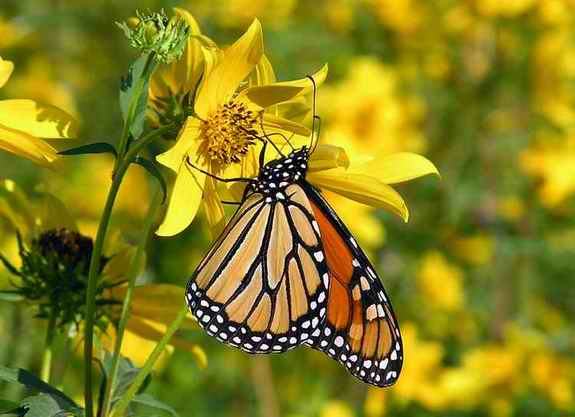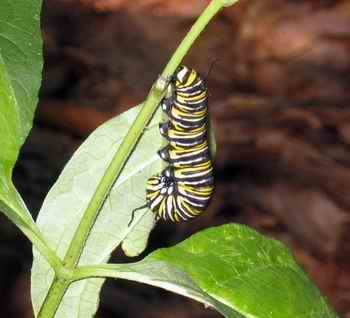|
Common Name: Monarch Butterfly, Milkweed Butterfly, King Billy (The name Monarch is probably related to the eponymous appellation "King Billy" used by Canadians; the butterfly has the black and orange colors associated with William of Orange, Coregent with Mary after the Glorious Revolution of 1688 and the hero of Protestant England for his victory over the Catholic James II at the Battle of the Boyne). Scientific Name: Danaus plexippus (the scientific name is variously translated from Greek as something between "sleepy transformation" and "Greek horse-driver")
The generic name of the Monarch is suggestive of its singular odyssey, migrating nearly the length of the North American continent every year. Danaus was a king of Argos who had 50 daughters, known as the Danaids. He promised them in marriage to the 50 sons of his brother Aegyptus but then ordered them to kill their new husbands to settle a grudge. The Danaids were condemned to eternally fill a bottomless bucket in Hades for their transgression. The species name plexippus means Argonaut, one of the peripatetic sailors who accompanied Jason in his quest for the Golden Fleece. Both the genus and species thus suggest the seemingly endless and nomadic migration of the Monarch.
The traditional understanding of the migration of the Monarch divides the population into a western group and an eastern group, though there is recent evidence of some crossovers. The western group consists of hundreds of thousands of individuals that travel from the western slopes of the Rocky Mountains to overwinter on more than 25 roosting sites along the California coast. Protecting this habitat from the encroachments of burgeoning human population led to the creation of the Monarch Project in 1984.
The eastern migration of the Monarch is much more circuitous and required a dedicated research effort to understand. After years of tagging butterflies, a Canadian zoologist named Dr. Fred Urquhart discovered the wintering site of millions of Monarchs in the transvolcanic Sierra Madre Mountains of Mexico in 1975. Subsequent research has revealed that tens of millions of Monarchs leave their summer breeding grounds east of the Rocky Mountains and fly to twelve mountain massifs in central Mexico. The Mexican habitat is also under assault. The groves of oyamel fir trees that provide the winter roosts for the Monarch are also valuable lumber trees that the local landowning ejidatarios depend on for income. Monarca A. C. is the Mexican counterpart to Monarch Watch and has established five sanctuaries since 1985.
The distance traveled over the course of the two to three month transit can range up to 2500 miles with an average speed of about 2 miles an hour. The longest recorded distance traveled by a tagged Monarch in one day was 265 miles from Waterford, Pennsylvania to central Virginia. One of the peculiarities of the Monarch life cycle is that one generation lives 6 to 9 months as it migrates from the north to the overwintering grounds in either California or Mexico. It is believed that the "Methuselah generation" results from genetic markers induced by cooler temperatures in early autumn. This generation not only migrates the entire distance to the winter havens, but begins the journey north in the spring.
The longevity of the southern bound Monarch contrasts sharply with the "normal generation" life cycle which passes through the egg, larva, and pupa stages in about a month, surviving as an adult for 2 to 6 weeks thereafter. The shorter life cycle is followed by the butterflies returning to the northern habitats so that those arriving at the northernmost reaches of the range are two to three generations removed from those that departed the previous year. It is hypothesized that the Monarch was originally a tropical butterfly that occupied an evolutionary niche in their consumption of the milkweed plant (Asclepias syriaca); gradually moving further north each spring to the extent that they reached a practical limit. As they never developed the ability to survive the cold, they were forced to return to the warmer south every winter.
The Monarch's consumption of the milkweed plant imbues it with a chemical defense against most predators. The cardenolides or cardiac glycosides of the milkweed are poisonous to most vertebrate animals so that there is little predation by birds, frogs, lizards, or mice. Monarchs would benefit little from their toxicity without a means of communicating this condition in advance of being ingested. This is the function of their brilliant coloration. The orange, black and white markings are ample warning that serves to remind potential predators of the poison. The hard body and wings of the Monarch allow it to survive an initial assault as an attacker takes its first bite. However, like the Monarch, some vertebrates have evolved to tolerate the milkweed toxin, notably Orioles, Grosbeaks, and scansorial black-eared mice. Invertebrate predators include spiders, protozoan parasites (Ophryocystis elektroscirrha) and wasp parasitoids. It is estimated that 95 percent of all Monarchs never reach the adult stage due to environmental causes (lack of food or habitat), accidents, and predation. |

